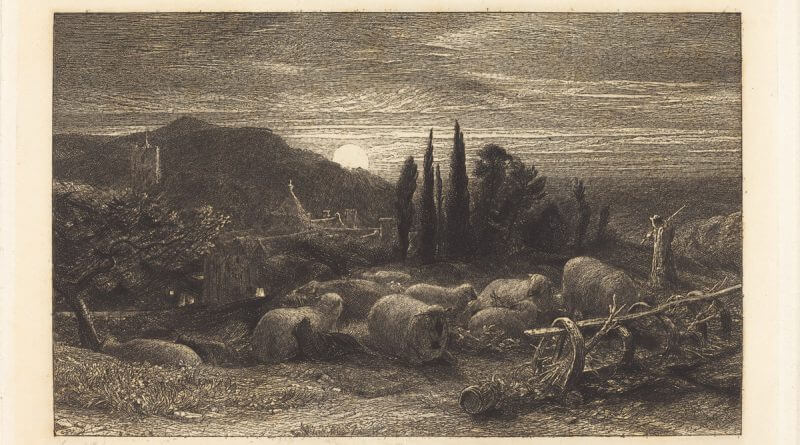Space Is The Place: The Night Sky Over Belper, March 2018
In the night sky over Belper, Venus appears low in the twilight sky this month, pairing with Mercury on the 3rd. The vernal equinox marks the first day of spring. Jupiter, Mars and Saturn are all visible – although you will have to stay up late, or get up early, to see them. There is a Blue Moon on the 31st.
Another Blue Moon: 31st of March.
There is a full Moon on the 2nd of March and another full Moon on the 31st. This means that the full Moon on the 31st is also a blue Moon (two full Moons in the same month).
Blue Moons normally appear about once every two to three years, but 2018 is a special year with two blue Moons occurring just two months apart – the last one was in January.
The Mountains of the Moon.
The full Moon is a glorious sight (see the image above, The Rising Moon by Samuel Palmer, courtesy of the Washington NGA archive) however, most observations are better when the Moon is in shadow.
You will notice that different features are highlighted as the Moon goes through its phases. For example, when there is a half Moon it is easier to see the mountains and mountain ranges that cluster around the Mare Imbrium.
The Mare Imbrium (or the Sea of Showers) is the large lava plain within the Imbrium basin. Caused by a mighty collision, the Imbrium basin has a diameter of nearly 711 miles across. It can be easily located, lying between the craters of Plato and Copernicus.
Mountains on Earth are caused by tectonic or volcanic activity; however, the Moon’s mountains are the result of impacts on the lunar surface. As such, it is not surprising that the biggest concentration of mountains are found around the large impact crater that forms the Imbrium basin.
You will need a telescope to spot the mountains. There is a good guide here, downloadable as a pdf (Majestic Mountains). The Sky at Night website also has a section on the Mountains of the Moon: Pete Lawrence’s Moon Guide: Section 4.
A target worth looking for is the shadow formed by the lone peak of Mons Piton. This mountain is about 1.4 miles high and sits in the top quarter of the Mare Imbrium. When the conditions are right, Mons Piton’s shadow can be seen stretching across the plains of the Mare Imbrium. You will need a telescope to see the shadow. Try to see if you can find it by looking at the half Moon on the 8th and the 24th of March.
The image here: The Moon at Third Quarter will give you an idea of what to look for. Check out the top of the image to spot Mons Piton and its shadow.
The Vernal Equinox. March 20th.
The vernal equinox is on Tuesday, March 20th, when day and night are of almost equal length. The vernal equinox is technically the beginning of Spring, although meteorologists use March the 1st as an indicator.
The Planets.
Jupiter:
Jupiter is a bright object rising at about midnight. Look towards the south-east to see it. The Moon is close to Jupiter on the 7th of March.
Mars and Saturn:
Mars rises in the south-east at around 4.00am and is nicely paired with Saturn at the moment. Both planets are shining brightly, low in the south-east.
On the 10th of March a waning Moon will be close to Mars and on the 11th it will pass close to Saturn.
Venus and Mercury:
Venus is visible low in the west just after sunset. The only problem is that you will need a low and unobstructed horizon to see it. Start looking about 45 minutes after sunset – it will be the bright twilight star low in the sky. On the 19th it will be below a thin crescent Moon.
If you can spot Venus you may also be able to spot Mercury – much fainter but nearby. On the 3rd of March they are very close (apparently next to each other). Start watching around 20 minutes after sunset to catch this.
International Space Station.
The Spot the Station site is currently showing viewing opportunities from the 2nd March – 15th of March. ISS appearing in the early morning in a time slot between 3.29am and 6.01am.
Spot the Station only gives information of sightings for two weeks in advance. To make sure of a sighting go to the Spot the Station website for the exact times and where to look in the sky.
A Sense Of Proportion: The Total Perspective Vortex.
Last month’s article celebrated Carl Sagan’s “Pale Blue Dot” speech. It has to be noted that Douglas Adams also touched upon this subject – with a slightly different conclusion. This is a nicely animated clip from the second series of the Hitchhiker’s Guide to the Galaxy.


GDPR, Your Data and Us: https://nailed.community/gdpr-your-data-and-us/